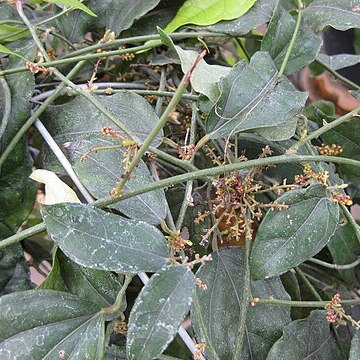Robust lianes. Leaves simple, petiolate; blade entire, penninerved. Male inflorescences of false racemes of condensed cymules, few-flowered, axillary or from the old stems, or of axillary, solitary, sometimes 1-flowered cymules. Male flowers with 6–12 sepals, glabrous or rarely partly puberulous, the outer bract-like, the inner much larger, obovate or elliptic, somewhat fleshy or coriaceous; petals 3–6; stamens 3–9, free or longly united; anthers introrse; thecae dehiscing longitudinally. Female inflorescences similar to the ♂, or more simple, sometimes as spikes of solitary flowers. Female flowers with sepals and petals similar to those of the; staminodes absent; carpels 6–30, borne on an apparent gynophore. Drupes ovate, stipitate; the remains of the stigma visible near the stipe; exocarp glabrescent, smooth or verrucose, endocarp compressed, woody, furrowed. Endosperm of seeds ruminate, sparse or absent.
Woody climbers, without prickles. Leaves with lamina penniveined and with basal veins present. Inflorescences axillary or cauliflorous, subracemose, composed of few-flowered cymes or, especially in female, of solitary flowers, without accrescent bracts. Male flowers: sepals 6–12, in whorls of 3, the outermost smallest, the innermost much larger and (in Australia) valvate apically, subimbricate basally; petals 6 (in Australia), equal; stamens 6 (in Australia), free. Female flowers: staminodes absent; carpels 9–12, inserted on a gynophore; style short, acute. Drupes subobovoid, borne on branches of carpophore; style-scar near base; endocarp bony, horseshoe-shaped, with dorsal transverse ridges. Seed horseshoe-shaped, with ruminate endosperm; cotyledons elongate, flattened.
Male flowers with 6–12 sepals, glabrous or rarely partly puberulous, the outer bract-like, the inner much larger, obovate or elliptic, somewhat fleshy or coriaceous; petals 3–6; stamens 3–9, free or somewhat united; anthers introrse; thecae dehiscing longitudinally.
Male inflorescences of false racemes of condensed cymules, few-flowered, axillary or from the old stems, or of axillary, solitary, sometimes 1-flowered cymules.
Drupelets ovoid, stipitate; the remains of the stigma visible near the stipe; exocarp glabrescent, smooth or verrucose, endocarp compressed, woody, furrowed.
Female flowers with sepals and petals similar to those of the male, staminodes absent; carpels 6–30, borne on an apparent gynophore.
Female inflorescences similar to the male, or more simple, sometimes as spikes of solitary flowers.
Leaves simple, lamina entire, penninerved.
Endosperm ruminate, scanty or absent.
Robust lianes.

